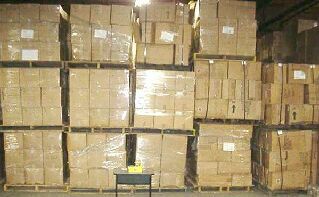
| MENU: HOME » SURVIVAL » Index of States |

Last year I emptied the old Canadian Admiral inventory of 7,000 pieces (consisting mostly of dosimeters) and some of you know how much trouble I had doing that. This is twenty times larger. Not only that - there may have been more than ten other inventories this size previously auctioned off by the government in the last several years. Those are sitting in other people's warehouses. There are tons of this stuff about but much of it is useless. The problem is in separating the gold from the dirt.
In the warehouse picture there is a desk in front of the pallets and on the desk there is sitting a single instrument. Perhaps a...
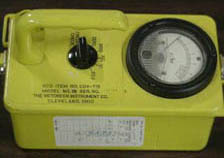 | 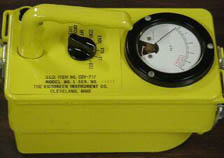 | 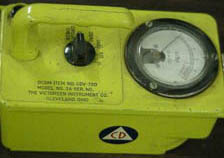 |
| CDV-715 | CDV-717 | CDV-720 |
These are most of the models in this particular inventory, although there are some other kinds also. We were concerned that while these meters looked nice many of them were probably now worthless because the government hadn't taken care of them. Just like in mining for diamonds in a diamond mine, a lot of overburden was going to have to be moved to find ones that work. In the end it turned out to be a very mixed bag. It all depended upon which state the pallets had come from. Some of the pallets had 90% working units and on other 90% of the units didn't work.
On the Internet and through locations like e-Bay you will find many similar types of detectors. Sometimes there may be from other warehouses ones that don't work and that cannot be repaired. In fact I have seen some of the ads state that they are for display and toys only. Those are not a bargain at any price. In fact they are a hazard. It is like having a fire extinguisher in your home that doesn't work - but you don't know it until you go to use it.
On the other hand others may be perfectly all right. It is a financial risk that one might take but it is not a survival risk that they should. Until now I did not have a very good solution to offer people. When people asked me where to get their meters checked I suggested that they contact a large local hospital radiology lab and ask if they knew where they should go, or perhaps the state radiological safety branch, if there was one. But now there is a new solution. The company to which I gave my free consultation has been able to establish a certified testing lab, and in fact are doing testing for a number of states themselves. I do not make a dime for recommending these folks and I honestly don't know where else I can send you.

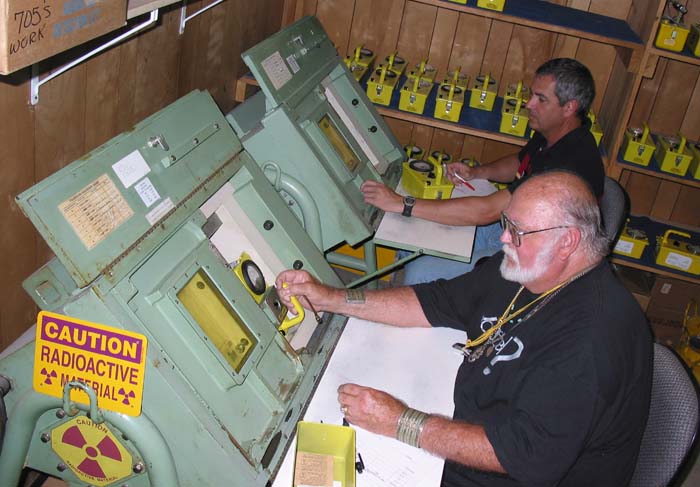
There are basically three categories of detectors:
RATE METERS
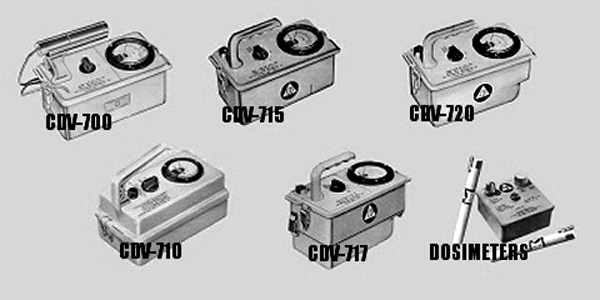
However rate meters are designed, they have a common purpose and that is to determine the rate of radiation. That is to say -how strong the radiation is. Some meters measure radiation only in low ranges and are pretty useless for nuclear war survival purposes. Others measure it only in high ranges (which is alright for our purpose), and still others (like the ones above) are switchable. To use a rate meter one needs to understand about the measurements or the rates of radiation, which I will explain on still another page. A rate meter tells you the amount of radiation you would receive if you were exposed for an hour to the source that you are measuring.
Rate meters need to be regularly (every couple of years, or in some legal situations - more often) tested and calibrated in order to know that they are functioning accurately. I would have to go into a lot of detail to explain how this is done but principally one needs to take the instrument to a lab that has a radioactive source and a trained technician. The cost for this service is currently running around $80US.
To buy a brand new good rate meter would today cost several hundred to fifteen hundred dollars. However, for nuclear survival purposes, very good tested older ones can be obtained for around $200.[The price has gone up considerably in the last year and at the moment is going up even more rapidly.] Unless you are dealing with a totally reliable and knowledgeable individual that you personally know, you should not pay a lot for an instrument that has not been recently certified. If you can get it cheaply enough, and you have some confidence in it then you can perhaps afford to take the risk and have it tested and calibrated.
If you do not have the money to buy a rate meter it does not mean that you can't have one. I have personally built a rate meter out of common scraps of material found around any home and you can do so also. This is not a toy and it will actually work and do the job. It is, however, better to buy one if you can afford to do so. Here are the directions to build your own.
DOSIMETERS
Dosimeters sort of do the opposite of a rate meter. They tell you how much dose (radiation) the dosimeter has already received, rather than the rate that radiation is currently occurring. If a person was wearing the dosimeter when it received the radiation then that person also has received that much radiation. You can't use the dosimeter like a thermometer and sort of tell later how much radiation a person has gotten unless the person was with the dosimeter when it was being radiated.
There are two major types of dosimeters. Badge dosimeters and rechargeable dosimeters. Badge dosimeters usually have to be sent to a laboratory for reading and their application is in peace time industrial safety situations and are not something that we are really concerned with here.
What you want is a rechargeable dosimeter. The really neat thing about a dosimeter is that you can also use it as a ratemeter - although it takes a little longer. A rate meter tells you how much radiation you are getting per hour, that is to say its reading will say something like so many R per hour - (I explain R and other measures of radioactivity on another page). If you leave a dosimeter in radiation for an hour - and then look at its reading that will also be the R per hour - which should be the same reading that you are getting off a rate meter. If the dosimeter was in the radiation for two hours then you could divide the number by two. Or for ten hours - then divide the number by ten. You get the idea but the disadvantage is that while dosimeter can be used to tell the average radiation for that time - it does not tell you what is happening right now. If I had to choose between owning only a rate meter or owning only a dosimeter - I would choose the dosimeter. I would certainly even prefer to have a dosimeter over building my own rate meter as I described above.
Dosimeters also come in low and high ranges. Once again low ranges are fairly useless for nuclear war purposes. New rechargeable dosimeters can cost two or three hundred dollars. Used low range dosimeters can cost about $80 and high range ones would be about $40. [A couple of years ago the high range ones were $10, or less, although the low range were still around $80 even then.] Fortunately, for our purposes we didn't want the more expensive low range ones anyway. Generally speaking, the ones that you see on the Internet have not been tested. One other neat thing about dosimeters is that you don't have to have one for every individual in a group. If one person in a group has an accurate dosimeter, then the reading on that dosimeter applies to everyone in the group if they have all been together during the exposure.
If you have a rechargeable dosimeter, then you must have a dosimeter charger. On another page . I show you how to read, recharge, and use a dosimeter.
Sampling versus Testing
If you can find a reliable source of a large number of dosimeters, you do not have to test every one of them. You can use a sampling procedure as we did for our group buy. This is a method of my own devising and I know of no one else who recommends it. It certainly would not meet peace time standards but I think it will serve admirably well for nuclear war survival. One simply tests a significantly large random sample of their total inventory and then projects the calculated reliablity to smaller batches randomly gathered from the same inventory. Now one can take a "vote" among the several instruments in the smaller batch and based upon the calculated reliability have confidence as to the actual readings. I actually prefer this method over having a single unit, no matter how expensive and recently calibrated - because I would have no way of knowing that the single unit had suddenly quit functioning. This procedure also applies equally well to rate meters.
Geiger Counters
Geiger counters are another story and while they would be a nice thing to have, they are so prohibitively expensive - running several hundred to thousands of dollars for a new one, and almost impossible to find in good working order used, that I will spend little time on them, although I have fortuitously been able to obtain one for use, after a nuclear war, for every Province in Canada. Geiger counters count the decay rate of radiation. More particulary, they also count beta radiation in addition to gamma radiation. Now this is important in surveying the safety of food and water but since this is more applicable to a post nuclear or recovery situation - I cover that subject on the RECOVERY pages rather than here.
| MENU: HOME » SURVIVAL » Index of States |